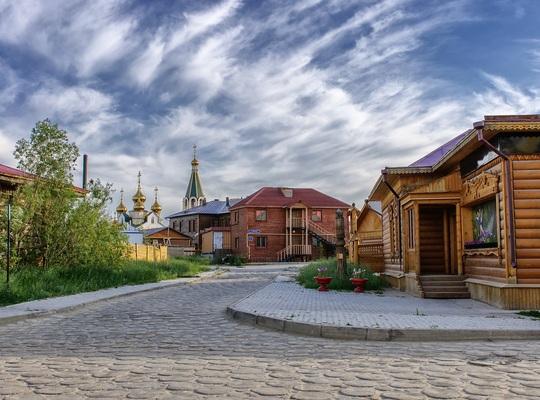
Key Takeaways:
-
Yakutsk is the coldest city on Earth, offering travelers once-in-a-lifetime experiences from ice museums to indigenous cultural tours.
-
Visitors are drawn to its mix of extreme climate, arctic landscapes, and rich Yakut heritage, making it a true year-round destination.
-
Whether you come for the frozen winters or the brief, vibrant summers, Yakutsk is a destination like no other.
Yakutsk, the capital of the Sakha Republic in northeastern Russia, is the world’s coldest major city — and perhaps one of its most intriguing. Founded in the 17th century as a Cossack fort, Yakutsk has evolved into a remote yet thriving city where Indigenous culture, science, and nature intersect in extraordinary ways. Despite the subarctic climate, Yakutsk is bursting with warmth — not just from its indoor heating but from its people, traditions, and sense of community. Locals embrace the extremes and have built a lifestyle that’s adapted to one of the most challenging climates on Earth. With permafrost museums, summer river festivals, and surreal frozen landscapes, this is a place where every season tells a different story.
Table of Contents
-
Explore the Mammoth Museum at North-Eastern Federal University
-
Take a Tour of the Permafrost Kingdom Ice Museum
-
Experience Traditional Yakut Cuisine in a Local Ger
-
Walk Along the Lena River in Summer
-
Visit the Treasury of the Republic of Sakha Museum
-
Attend the Ysyakh Festival in June
-
Take a Frozen Dog Sled Ride in Winter
-
Discover Tuymaada Valley’s Natural Beauty
-
Go Underground at the Yakutsk Diamond Museum
-
Visit the National Art Museum of the Sakha Republic
1. Explore the Mammoth Museum at North-Eastern Federal University
Yakutsk is a hotbed of paleontological discoveries, and the Mammoth Museum showcases one of the world’s most unique collections of Ice Age fossils. Housed inside the North-Eastern Federal University, this scientific and educational center displays preserved woolly mammoth remains, ancient bison skulls, and even frozen cave lion cubs. What makes this place exceptional is that many of the specimens were discovered in the surrounding permafrost and remain astonishingly intact. It’s a rare glimpse into a prehistoric world that’s still being unearthed today.
The museum also highlights the role of climate and geology in preserving these finds, making it a fascinating stop for science lovers and the curious alike. English-speaking guides are available, and tours provide context on both the research and cultural significance of these animals to the local Yakut people. Interactive exhibits and 3D models make it engaging for all ages. It’s one of the few places in the world where you can stand just inches from a real woolly mammoth skull — and that alone is worth the trip.
2. Take a Tour of the Permafrost Kingdom Ice Museum
Deep beneath a hillside in Yakutsk lies the Permafrost Kingdom, an otherworldly ice museum carved directly into the permafrost. This surreal attraction is a tunnel system filled with glowing sculptures, frozen chambers, and illuminated ice carvings — all kept naturally preserved by the below-zero temperatures year-round. It’s like walking into a magical Arctic fairy tale, with frozen thrones, mythical creatures, and icy corridors stretching in all directions.
The temperature inside remains steady at about -10°C (14°F) even in summer, so dress warmly regardless of the season. Guides offer tours that explain how permafrost affects architecture, agriculture, and daily life in Yakutia. It’s part art gallery, part science center, and entirely unforgettable. For photos, atmosphere, and insight into the region’s icy reality, the Permafrost Kingdom delivers.
3. Experience Traditional Yakut Cuisine in a Local Ger
For a true cultural immersion, sit down to a Yakut meal inside a traditional ger (yurt-style tent) hosted by Indigenous locals. Here, you’ll sample dishes like stroganina (thinly sliced frozen fish), horse meat sausage, and creamy dairy products made from reindeer or mare’s milk. Meals are often served with kymys (fermented horse milk) or herbal teas made from local tundra plants.
The experience is more than just food — it’s storytelling, song, and hospitality rolled into one. Hosts often explain the cultural significance of each dish and may perform Yakut songs or share legends passed down through generations. You’ll leave full and inspired, having glimpsed life through a completely different lens. This isn’t a tourist trap — it’s a heartfelt tradition that locals are proud to share.
4. Walk Along the Lena River in Summer
Though winters dominate Yakutsk’s reputation, summer brings a dramatic transformation as the Lena River thaws and the landscape bursts into green. Locals head to the riverbanks to picnic, swim, and enjoy the midnight sun — the city sees nearly 20 hours of daylight in June and July. The riverside paths are perfect for a walk, bike ride, or boat trip, offering wide views of the surrounding plains and cliffs.
Seasonal cafés pop up along the shore, and live music events sometimes take place near the ferry terminals. You’ll see kids splashing in the water and fishermen casting lines while hawks glide overhead. It’s a relaxed, joyful side of Yakutsk that contrasts sharply with its winter identity. If you’re lucky, you may even catch a river festival or fireworks show lighting up the summer sky.
5. Visit the Treasury of the Republic of Sakha Museum
The Treasury of the Republic of Sakha is a dazzling museum that tells the story of Yakutia’s vast natural resources — especially its legendary diamonds and precious stones. This region is one of the world’s top diamond producers, and the museum showcases glittering examples along with gold, silver, and rare minerals. The exhibits include both raw stones and intricately crafted jewelry, reflecting the artistry and wealth of the land.
You’ll also learn about the geology and mining techniques used in this challenging environment. The museum is designed with elegance and pride, and offers guided tours in multiple languages. Visitors leave with a greater appreciation of Yakutia’s mineral power — and why it plays such a significant role in Russia’s economy. For lovers of luxury, science, or culture, this spot shines bright year-round.
6. Attend the Ysyakh Festival in June
One of Yakutia’s most important cultural events, the Ysyakh Festival is a vibrant summer celebration of renewal, fertility, and Yakut identity. Held in late June during the solstice, this event brings thousands of people together in traditional dress to honor the sun, the earth, and ancestral spirits. Expect massive gatherings with dancing, osukhai (ritual circle dances), horse racing, throat singing, and ceremonial offerings of fermented mare’s milk.
The atmosphere is colorful, spiritual, and deeply joyful, offering a powerful look into Yakut traditions that predate Christianity. Families camp out in decorated tents, children participate in folk games, and the smell of grilled meats fills the air. If you’re visiting Yakutsk in summer, attending Ysyakh is an absolute must. It’s more than a festival — it’s a living connection to centuries of Indigenous culture and pride.
7. Take a Frozen Dog Sled Ride in Winter
When winter blankets Yakutsk in deep snow and temperatures plunge to -40°C or lower, it’s time for an iconic Arctic experience: a dog sled ride. Outside the city, trained huskies and mushers guide you through frozen forests and wide, open tundra. The silence of the snowy landscape is surreal — interrupted only by the breath of the dogs and the crunch of the sled on ice.
Tours range from 30-minute loops to half-day adventures and are available from local outfitters between November and March. Most rides also include warm tea, snacks, and photo opportunities with the huskies. It’s thrilling, peaceful, and uniquely Siberian. If you’ve ever dreamed of exploring the wilderness like an Arctic explorer, this is your chance.
8. Discover Tuymaada Valley’s Natural Beauty
Just a short drive from the city, Tuymaada Valley offers a striking contrast to the urban freeze — a green, flower-filled plain in summer and a sparkling snowfield in winter. This valley is sacred to the Yakut people and plays a central role in local folklore and seasonal festivals. It’s also a favorite spot for hiking, cross-country skiing, and wildlife photography.
The valley is home to rare plants and birds, and its wide vistas give you a sense of Yakutia’s vast, untouched wilderness. Come during summer for wildflowers and solitude, or during winter for frost-covered trees and icy silence. Pack a thermos and your camera — the views are unforgettable. It’s a soul-stirring escape that shows how beauty thrives in extremes.
9. Go Underground at the Yakutsk Diamond Museum
While the Treasury museum displays Yakutia’s gems, the Yakutsk Diamond Museum goes deeper — literally and figuratively — into how the region extracts and values its most precious resource. Set in a secure facility, the museum walks you through the full diamond journey: from geological formation and mining to cutting, grading, and final export.
Exhibits include massive rough stones, high-tech tools, and even simulated diamond sorting labs. You’ll gain insight into how Yakutia became one of the world’s diamond powerhouses — and how it balances economy with ecology in these efforts. Guided tours are recommended, and some even end in a small showroom where you can purchase locally cut stones. It’s luxury, science, and history all in one immersive stop.
10. Visit the National Art Museum of the Sakha Republic
If you want to understand Yakutia beyond its climate, head to the National Art Museum, which showcases traditional Yakut art alongside modern interpretations by Indigenous and Russian artists. The collection spans textiles, sculptures, paintings, and carvings that reflect themes of nature, folklore, and spiritual connection.
Permanent exhibits are complemented by rotating shows and cultural workshops, often led by local creators. The building itself is sleek and modern, making it a comfortable retreat on especially cold days. Audio guides and English signage help international visitors fully appreciate the stories behind the works. It’s a quiet but moving space that helps you see Yakutia through the eyes of its artists.
What to do if you have kids?
Yakutsk is surprisingly family-friendly, even in the cold. Kids will be amazed by the glowing tunnels of the Permafrost Kingdom and the ice sculptures in the city square during winter festivals. The Mammoth Museum is both educational and exciting, while sled rides and riverside walks provide fresh air and fun. Restaurants are warm and welcoming, and locals often go out of their way to help families feel comfortable. Just be sure to pack the right gear — layers, boots, and mittens are essential for little ones.
Where can I find free events in Yakutsk Russia taking place this weekend?
Looking to discover what’s happening in Yakutsk this weekend — for free? Head over to https://planmyweekend.ai. Our tool scans and curates local activities like art exhibitions, folk concerts, outdoor markets, and cultural celebrations happening around the city. Whether you’re in town for the Ysyakh Festival or just want to catch a winter fireworks display, we’ll show you where to go and when. Explore more, spend less, and enjoy Yakutsk like a local.
Final Thoughts
Yakutsk may be remote, but it offers one of the richest, most memorable travel experiences in the world. From ancient mammoths and glowing permafrost to Indigenous festivals and riverside strolls, every day here feels like stepping into another world. The extremes — in weather, culture, and nature — are what make it so unforgettable. Whether you visit in winter’s icy grip or during the lush light of summer, Yakutsk will expand your perspective and warm your heart.
Author: Dejon Brooks
Dejon Brooks is an entrepreneur who founded Trend Watchers with his life savings. Aged 24, Dejon has turned Trend Watchers into a successful business. After reaching over 150M+ people on his personal accounts, he now spends his time growing Planmyweekend.ai


